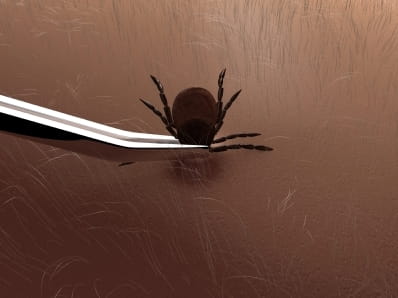Lyme Disease Causes, Symptoms and Treatments

The Bottom Line
Lyme disease is an infection caused by tick bites. Infected ticks are carried by deer and other outdoor animals. Lyme disease usually causes a rash around the bite. Other early symptoms can include chills, fever, headache, fatigue, and joint pain. Joints, the nervous system, and the heart are sometimes damaged. Lyme disease is treated with antibiotics.

The Full Story
In 2012, more than 22,000 people in the U.S. developed Lyme disease, according to the Centers for Disease Control and Prevention (CDC). Most cases were in the Northeast and Midwest states. The ticks that cause Lyme disease become active in the springtime. Infections peak in May, June, and July.
Lyme disease is an infection caused by black-legged ticks, sometimes called deer ticks. (The Latin name is Ixodes scapularis.) To cause disease in humans or companion animals, two things are needed:
- The tick itself must be infected with a bacterium called Borrelia burgdorferi. This happens when the tick bites an infected animal such as a small rodent, bird, or other mammal.
- The infected tick then must bite its victim and stay attached for more than 36 hours. During this time, the tick is actually feeding, or taking a "blood meal". While this is happening, the tick increases in size - and introduces the infection into its victim.
Ticks go through a two-year life cycle in moist, woody, leafy areas. Humans and pets contact ticks when they hike, camp, play, or work in those settings. Ticks also attach to larger animals, especially deer. When deer wander close to homes and play areas, they bring the ticks along. Ticks may brush off onto shrubs and grass, where humans and pets in turn brush against them.
Deer tick nymphs are the life stage found in the springtime. These nymphs are tiny, about the size of a poppy seed. Because of that, people may not notice an attached nymph unless it gets much larger from its blood meal. By then, an infected tick may have passed along Lyme disease.
Lyme disease is well-known for causing a rash around the bite. About 68 percent of Lyme disease sufferers experience this red-and-white "bulls-eye". It usually occurs about 3 to 14 days after the bite. Other early symptoms can include chills, fever, headache, fatigue, and joint pain.
Over the past several years, about a third of patients with Lyme disease symptoms developed arthritis. Nearly 10 percent had effects on muscles and nerves of their faces. In rare cases, patients had serious effects on the nervous system or the heart. These more serious effects might not show up for months after the bite.
Many illnesses can mimic many symptoms of Lyme disease. Lyme disease usually can be diagnosed by a blood test, but not right away. The blood tests measure antibodies to the Lyme disease organism; it can take our bodies weeks to develop the antibodies that can be measured for these tests.
Lyme disease is treated with antibiotics. Since blood tests are not always available or useful, treatment may depend on symptoms. Antibiotics are generally prescribed if someone:
- was bitten by a tick in the past few weeks and has a "bulls-eye" rash;
- was bitten recently by a tick and has common symptoms of Lyme disease, with no other explanation for those symptoms;
- has symptoms that suggest Lyme disease, plus a positive blood test.
If a person had a tick bite but has no symptoms, antibiotics generally are not recommended. All drugs, including antibiotics, have side effects. Also, unneeded antibiotics can promote "antibiotic resistance" - infections that don't respond as they should to antibiotics.
The best treatment for Lyme disease is prevention.[1] Take specific steps to avoid ticks, keep them from biting, and remove them if they do attach to you, a child, or a pet. Here are recommendations from CDC:
- Avoid areas likely to harbor ticks - brush, overgrown grass, and leaf litter. If walking in the woods, stick to the center of the trail.
- Use insect repellent containing 20 percent DEET. (DEET also will repel mosquitoes.) Use it on exposed skin, except around the eyes. An adult should apply it to children. Follow label instructions carefully; DEET is safe when used as it should be.
- An insect repellent containing permethrin can be applied to clothing and shoes. Again, follow label instructions exactly.
- Take a bath or shower as soon as possible after coming indoors. There are three reasons: to wash off any ticks that aren't attached; to find attached ticks; and to wash off remaining insect repellent.
- At least once a day, check for ticks on children, pets, and yourself. Especially, check the armpits, groin, behind the ears, and scalp. Finding and removing ticks promptly can help prevent an infection.
- If you find an attached tick, remove it with tweezers. Grab the head right at the surface of your skin. Gently and firmly pull the tick out. Clean the bite area well. (Do NOT use a hot match, petroleum jelly, or other methods to remove the tick.)
Call Poison Control at 1-800-222-1222 for more information about ticks and tick bites. If you do find and remove a tick, Poison Control will stay in touch with you by phone to advise you about any symptoms. If you find and remove a tick from your pet, call your veterinarian right away if the animal becomes ill.
______________________[1] There is a Lyme disease vaccine for dogs, but not for humans or cats.
Rose Ann Gould Soloway, RN, BSN, MSEd, DABAT emerita
Clinical Toxicologist
Poisoned?
CALL 1-800-222-1222
Prevention Tips
Take specific steps to avoid ticks, keep them from biting, and remove them if they do attach to you, a child, or a pet.
- Avoid areas likely to harbor ticks – brush, overgrown grass, and leaf litter.
- Use insect repellent containing 20 percent DEET. (DEET also will repel mosquitoes.)
- An insect repellent containing permethrin can be applied to clothing and shoes.
- Take a bath or shower as soon as possible after coming indoors.
- At least once a day, check for ticks on children, pets, and yourself.
- If you find an attached tick, remove it with tweezers.
This Really Happened
A 50-year-old Virginia woman was seen at a local clinic with extreme headaches, fever with shivering cold spells, severe generalized joint pain, excessive thirst and fluid intake and a spreading rash on her back. She had a large circular red rash on her back with a bull’s-eye appearance, 16 x 18 cm (6 x 7 inches) in diameter. Her temperature was 104.4 degrees Fahrenheit. A blood test confirmed Lyme disease. The patient recalled walking through the woods 3 weeks before, although she never noticed a tick on her body.
She was placed on a 30-day course of the antibiotic doxycycline due to the extent of her symptoms. Two weeks after completing the antibiotic, the patient began experiencing lower extremity neuralgia (pain along the course of a nerve) as well as tingling in her hands. Her physician prescribed a second 30-day course of doxycycline as well as gabapentin (an amino acid, used in treatment of neuralgia). She was also referred to a physician with extensive experience in treating Lyme disease for continuing medical management. A year after she first presented to the clinic, her symptoms included chronic fatigue and intermittent joint pain requiring a cane to help her walk at times. Her only medication was methylphenidate (a central nervous system stimulant) for fatigue. She was considered to have post-treatment Lyme disease syndrome.
Reference: Palmieri, J.R., King, S., Case, M., & Santo, A. (2013). Lyme disease: case report of persistent Lyme disease from Pulaski County, Virginia. International Case Reports Journal, 6, 99-105.
For More Information
Recommendations for preventing Lyme Disease (CDC)References
Poisoned?
CALL 1-800-222-1222
Prevention Tips
Take specific steps to avoid ticks, keep them from biting, and remove them if they do attach to you, a child, or a pet.
- Avoid areas likely to harbor ticks – brush, overgrown grass, and leaf litter.
- Use insect repellent containing 20 percent DEET. (DEET also will repel mosquitoes.)
- An insect repellent containing permethrin can be applied to clothing and shoes.
- Take a bath or shower as soon as possible after coming indoors.
- At least once a day, check for ticks on children, pets, and yourself.
- If you find an attached tick, remove it with tweezers.
This Really Happened
A 50-year-old Virginia woman was seen at a local clinic with extreme headaches, fever with shivering cold spells, severe generalized joint pain, excessive thirst and fluid intake and a spreading rash on her back. She had a large circular red rash on her back with a bull’s-eye appearance, 16 x 18 cm (6 x 7 inches) in diameter. Her temperature was 104.4 degrees Fahrenheit. A blood test confirmed Lyme disease. The patient recalled walking through the woods 3 weeks before, although she never noticed a tick on her body.
She was placed on a 30-day course of the antibiotic doxycycline due to the extent of her symptoms. Two weeks after completing the antibiotic, the patient began experiencing lower extremity neuralgia (pain along the course of a nerve) as well as tingling in her hands. Her physician prescribed a second 30-day course of doxycycline as well as gabapentin (an amino acid, used in treatment of neuralgia). She was also referred to a physician with extensive experience in treating Lyme disease for continuing medical management. A year after she first presented to the clinic, her symptoms included chronic fatigue and intermittent joint pain requiring a cane to help her walk at times. Her only medication was methylphenidate (a central nervous system stimulant) for fatigue. She was considered to have post-treatment Lyme disease syndrome.
Reference: Palmieri, J.R., King, S., Case, M., & Santo, A. (2013). Lyme disease: case report of persistent Lyme disease from Pulaski County, Virginia. International Case Reports Journal, 6, 99-105.
